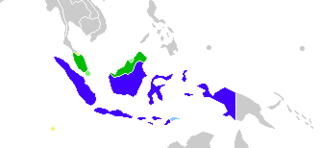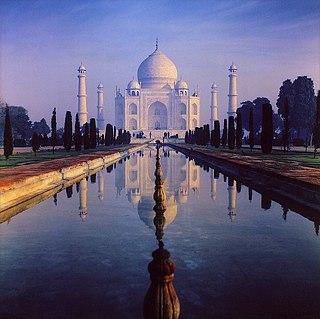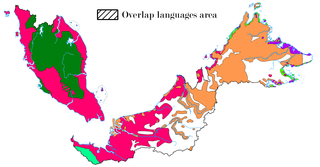Related Research Articles

Malay is an Austronesian language spoken in Brunei, Indonesia, Malaysia and Singapore, as well as parts of Thailand. A language of the Malays, it is spoken by 290 million people across the Strait of Malacca, including the coasts of the Malay Peninsula of Malaysia and the eastern coast of Sumatra in Indonesia and has been established as a native language of part of western coastal Sarawak and West Kalimantan in Borneo. It is also used as a trading language in the southern Philippines, including the southern parts of the Zamboanga Peninsula, the Sulu Archipelago and the southern predominantly Muslim-inhabited municipalities of Bataraza and Balabac in Palawan.
Malaysian English (MyE), formally known as Malaysian Standard English (MySE), is a form of English used and spoken in Malaysia. While Malaysian English can encompass a range of English spoken in Malaysia, some consider to be it distinct from the colloquial form commonly called Manglish. According to the English Proficiency Index, the average level of English in Malaysia is B1 on the CEFR scale.

Malays are an Austronesian ethnic group and nation native to the Malay Peninsula, eastern Sumatra of Indonesia and coastal Borneo, as well as the smaller islands which lie between these locations — areas that are collectively known as the Malay world. These locations are today part of the nations of Malaysia, Brunei, Singapore, Indonesia and Southern Thailand.
Education in Malaysia is overseen by the Ministry of Education. Although education is the responsibility of the Federal Government, each state and federal territory has an Education Department to co-ordinate educational matters in its territory. The main legislation governing education is the Education Act 1996.

Jawi is the Malay's alphabet after the arrival of Islam to Malay Archipelago.It is an Arabic script for writing Malay, Acehnese, Banjarese, Minangkabau, Tausūg and several other languages in Southeast Asia.
Mabel Lee is a translator of the works of Nobel Prize-winning author Gao Xingjian. She has taught Asian studies at the University of Sydney and is one of Australia's leading authorities on Chinese cultural affairs. Lee was a professor of South-East Asian Studies at Sydney University and had already begun translation of the poems of Chinese writer, Yang Lian when she met Gao Xingjian, in Paris in 1991. After that meeting, Lee offered to translate Soul Mountain, a project which took seven years, and an additional two to find a publisher for the book in Australia. Following publication, Gao Xingjian became the first Chinese to win a Nobel Prize in Literature.

Chinese-speaking world or Sinophone or sinophone is a neologism that fundamentally means "Chinese-speaking", typically referring to a person who speaks at least one variety of Chinese. Academic writers use Sinophone "Chinese-speaking regions" in two ambiguous meanings: either specifically "Chinese-speaking areas where it is a minority language, excluding China and Taiwan" or generally "Chinese-speaking areas, including where it is an official language". Many authors use the collocation Sinophone world to mean the regions of Chinese diaspora outside of Greater China, and some for the entire Chinese-speaking world. Mandarin Chinese is the most commonly spoken language today, with over one billion people, approximately 20% of the world population, speaking it.
The Malaysian language or Malaysian Malay, is the name regularly applied to the Malay language used in Malaysia. Constitutionally, however, the official language of Malaysia is Malay, but the government from time to time refers to it as Malaysian. Standard Malaysian is a standard form of the Johore-Riau dialect of Malay. It is spoken by much of the Malaysian population, although most learn a vernacular form of Malay or other native language first. Malay is a compulsory subject in primary and secondary schools.
The culture of Malaysia draws on the varied cultures of the different people of Malaysia. The first people to live in the area were indigenous tribes that still remain; they were followed by the Malays, who moved there from mainland Asia in ancient times. Chinese and Indian cultural influences made their mark when trade began with those countries, and increased with immigration to Malaysia. Other cultures that heavily influenced that of Malaysia include Persian, Arabic, British. The many different ethnicities that currently exist in Malaysia have their own unique and distinctive cultural identities, with some crossover.
Victor Henry Mair is an American sinologist. He is a professor of Chinese at the University of Pennsylvania. Among other accomplishments, Mair has edited the standard Columbia History of Chinese Literature and the Columbia Anthology of Traditional Chinese Literature. Mair is the series editor of the Cambria Sinophone World Series, and his book coauthored with Miriam Robbins Dexter, Sacred Display: Divine and Magical Female Figures of Eurasia, won the Sarasvati Award for the Best Nonfiction Book in Women and Mythology.

Malaysia is a country in Southeast Asia. The federal constitutional monarchy consists of thirteen states and three federal territories, separated by the South China Sea into two regions, Peninsular Malaysia and Borneo's East Malaysia. Peninsular Malaysia shares a land and maritime border with Thailand and maritime borders with Singapore, Vietnam, and Indonesia. East Malaysia shares land and maritime borders with Brunei and Indonesia and a maritime border with the Philippines and Vietnam. Kuala Lumpur is the national capital and largest city while Putrajaya is the seat of the federal government. With a population of over 30 million, Malaysia is the world's 44th most populous country. The southernmost point of continental Eurasia is in Tanjung Piai. In the tropics, Malaysia is one of 17 megadiverse countries, home to a number of endemic species.

Bahasa Rojak or Rojak language is a Malaysian pidgin formed by code-switching among two or more of the many languages of Malaysia. Bahasa means "language", while rojak means "mixture" in Malay, and is a local food of the same name.

Malay is a major language of the Austronesian language family. Over a period of two millennia, from a form that probably consisted of only 157 original words, Malay has undergone various stages of development that derived from different layers of foreign influences through international trade, religious expansion, colonisation and developments of new socio-political trends. The oldest form of Malay is descended from the Proto-Malayo-Polynesian language spoken by the earliest Austronesian settlers in Southeast Asia. This form would later evolve into Old Malay when Indian cultures and religions began penetrating the region. Old Malay contained some terms that exist today, but are unintelligible to modern speakers, while the modern language is already largely recognisable in written Classical Malay of 1303 CE.
Malaysian Mandarin is a variety of Mandarin Chinese spoken in Malaysia by ethnic Chinese in Malaysia. Malaysian Chinese tend to perceive the Mandarin Chinese is a variation of Standard Mandarin (Putonghua); however, it is a Mandarin dialect in its own right. Its closest linguistic cousin is not Standard Mandarin, rather it is Singaporean Mandarin, the variety widely used in films like Tiger Woohoo 大日子(2010), Namewee's Nasi Lemak 2.0 and movies created by Singaporean movie director Jack Neo.

Malaysian Malays are Malaysians of Malay ethnicity whose ancestry originates wholly or partly in the Malay world. In 2015 population estimate, Malaysian Malays form 50.8% of the total population of Malaysia or 15.7 million people. They can be broadly classified into two main categories; Anak Jati and Anak Dagang.

The indigenous languages of Malaysia belong to the Mon-Khmer and Malayo-Polynesian families. The national, or official, language is Malay which is the mother tongue of the majority Malay ethnic group. The main ethnic groups within Malaysia comprise the Malays, Chinese and Indians, with many other ethnic groups represented in smaller numbers, each with its own languages. The largest native languages spoken in East Malaysia are the Iban, Dusunic, and the Kadazan languages. English is widely understood and spoken in service industries and is a compulsory subject in primary and secondary school. It is also the main language spoken in most private colleges and universities. English may take precedence over Malay in certain official contexts as provided for by the National Language Act, especially in the states of Sabah and Sarawak, where it may be the official working language.
Malaysian literature is the collection of literary works produced in the Malay peninsula until 1963 and in Malaysia thereafter. Malaysian literature is typically written in any of the country's four main languages: Malay, English, Chinese and Tamil. It portrays various aspects of Malaysian life and comprises an important part of the culture of Malaysia.
Malaysia is a multi-ethnic country, with a predominately Muslim population. Accusations of racism stem from racial preferences embodied within the social and economic policy of the Malaysian government, as well as broader tensions between various ethnic groups. The concept of Ketuanan Melayu or Malay supremacy is accepted in the political sphere by many Malays. Discrimination is widespread, publicly displayed and accepted, ranging from implied ethnic supremacy to religious intolerance. Charging non-Malays more for services is very common.
Malaysians are the people who are identified with the country of Malaysia, its citizens and their descendants worldwide. This connection may be residential, legal, historical, or cultural. For most Malaysians, several of those types of connections exist and are the source(s) of their being considered Malaysians. Although citizens make up the majority of Malaysians, non-citizen residents and overseas Malaysians may also claim a Malaysian identity.
References
- ↑ Groppe, Alison M. (2013). Sinophone Malaysian Literature: Not Made in China. Cambria World Sinophone Series . Cambria Press.